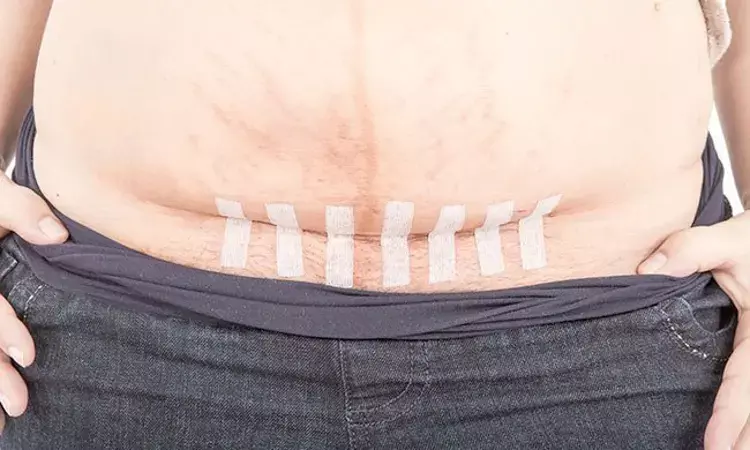- Home
- Medical news & Guidelines
- Anesthesiology
- Cardiology and CTVS
- Critical Care
- Dentistry
- Dermatology
- Diabetes and Endocrinology
- ENT
- Gastroenterology
- Medicine
- Nephrology
- Neurology
- Obstretics-Gynaecology
- Oncology
- Ophthalmology
- Orthopaedics
- Pediatrics-Neonatology
- Psychiatry
- Pulmonology
- Radiology
- Surgery
- Urology
- Laboratory Medicine
- Diet
- Nursing
- Paramedical
- Physiotherapy
- Health news
- Fact Check
- Bone Health Fact Check
- Brain Health Fact Check
- Cancer Related Fact Check
- Child Care Fact Check
- Dental and oral health fact check
- Diabetes and metabolic health fact check
- Diet and Nutrition Fact Check
- Eye and ENT Care Fact Check
- Fitness fact check
- Gut health fact check
- Heart health fact check
- Kidney health fact check
- Medical education fact check
- Men's health fact check
- Respiratory fact check
- Skin and hair care fact check
- Vaccine and Immunization fact check
- Women's health fact check
- AYUSH
- State News
- Andaman and Nicobar Islands
- Andhra Pradesh
- Arunachal Pradesh
- Assam
- Bihar
- Chandigarh
- Chattisgarh
- Dadra and Nagar Haveli
- Daman and Diu
- Delhi
- Goa
- Gujarat
- Haryana
- Himachal Pradesh
- Jammu & Kashmir
- Jharkhand
- Karnataka
- Kerala
- Ladakh
- Lakshadweep
- Madhya Pradesh
- Maharashtra
- Manipur
- Meghalaya
- Mizoram
- Nagaland
- Odisha
- Puducherry
- Punjab
- Rajasthan
- Sikkim
- Tamil Nadu
- Telangana
- Tripura
- Uttar Pradesh
- Uttrakhand
- West Bengal
- Medical Education
- Industry
Layered closure of upper abdominal transverse incisions carry a lower risk of incisional-SSIs: study

In comparison to mass closure, layered closure of upper abdominal transverse incisions is significantly associated with fewer incisional surgical site infections (SSI), as per a recent study published in Annals of Surgery.
A group of researchers conducted a study to compare the early results of mass and layered closure of upper abdominal transverse incisions. Contrary to midline incisions, data on the closure of transverse abdominal incisions are lacking.
This is the first analysis of a randomized controlled trial primarily designed to compare mass with layered closure of transverse incisions with respect to incisional hernias. Patients undergoing laparotomy through upper abdominal transverse incisions were randomized to either mass or layered closure with continuous sutures. Incisional surgical site infection (incisional-SSI) was the primary end-point. Secondary end-points comprised suture-to-wound length ratio (SWLR), closure duration, and fascial dehiscence.
The Results of the study are as follows:
A total of 268 patients were randomized to either mass (n=134) or layered (n=134) closure. Incisional-SSIs occurred in 24 (17.9%) and 8 (6.0%) patients after mass and layered closure, respectively (P =0.004), with crude odds ratio (OR) of 0.29 [95% confidence interval (95% CI) 0.13–0.67; P =0.004]. The layered technique was independently associated with fewer incisional-SSIs (OR: 0.29; 95% CI 0.12–0.69; P =0.005). The number needed to treat, absolute, and relative risk reduction for layered technique in reducing incisional-SSIs was 8.4 patients, 11.9%, and 66.5%, respectively. Dehiscence occurred in one (0.8%) patient after layered closure and in two (1.5%) patients after mass closure (P >0.999). Median SWLR were 8.1 and 5.6 (P <0.001) with median closure times of 27.5 and 25.0 minutes (P =0.044) for layered and mass closures, respectively.
Thus, the researchers concluded that layered closure of upper abdominal transverse incisions should be preferred due to lower risk of incisional-SSIs and higher SWLR, despite clinically irrelevant longer duration.
Reference:
Incisional Surgical Site Infections After Mass and Layered Closure of Upper Abdominal Transverse Incisions: First Results of a Randomized Controlled Trial by Grąt, Michał et al. published in the Annals of Surgery.
https://journals.lww.com/annalsofsurgery/fulltext/2021/11000/incisional_surgical_site_infections_after_mass_and.3.aspx
Dr. Shravani Dali has completed her BDS from Pravara institute of medical sciences, loni. Following which she extensively worked in the healthcare sector for 2+ years. She has been actively involved in writing blogs in field of health and wellness. Currently she is pursuing her Masters of public health-health administration from Tata institute of social sciences. She can be contacted at editorial@medicaldialogues.in.
Dr Kamal Kant Kohli-MBBS, DTCD- a chest specialist with more than 30 years of practice and a flair for writing clinical articles, Dr Kamal Kant Kohli joined Medical Dialogues as a Chief Editor of Medical News. Besides writing articles, as an editor, he proofreads and verifies all the medical content published on Medical Dialogues including those coming from journals, studies,medical conferences,guidelines etc. Email: drkohli@medicaldialogues.in. Contact no. 011-43720751


